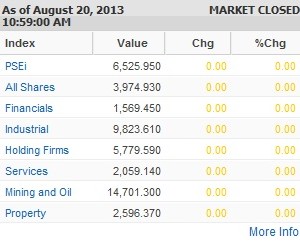
Local financial markets are bracing for a very rough ride when trading resumes Thursday after a three-day break that forced them out of the action while other Asian emerging markets wrestled against capital flight arising from anticipated tapering of US easy money policy.
Local financial markets are bracing for a very rough ride when trading resumes Thursday after a three-day break that forced them out of the action while other Asian emerging markets wrestled against capital flight arising from anticipated tapering of US easy money policy.
But while global investors tend to treat Asian emerging markets as one big basket, local market experts are mostly optimistic that Philippine assets–backed by better economic fundamentals compared to the Asian currency crisis on 1997—to at least fare better than their heavily battered peers.
“Offhand, the peso could be affected but I don’t expect it to be much. The story-line in other markets is negative current account and balance of payments. We don’t have those issues,” Antonio Moncupa Jr., president of East West Bank and chair of the Banker Association of the Philippines’ open market committee, said Wednesday.
“But of course, it is also not surprising if we get to be somehow affected by the aftershocks of the emerging market earthquake, but at least we are not in the epicenter,” he said.
With the recent fall of asset markets in India, Indonesia and Thailand alongside the slump in Wall Street, Banco de Oro Unibank chief strategist Jonathan Ravelas said the main-share Philippine Stock Exchange index may retest the 6,350 level alongside the trend of a strengthening US dollar that has bludgeoned the Indonesian rupiah and the Indian rupee. “So far we are better off. But I am biased to see the dollar/peso (exchange rate) to test 44 levels,” Ravelas said.
The PSEi finished at 6,525.95, about 11.8 percent down from the historical peak seen earlier in the year, while the peso last traded at the spot foreign exchange market last Friday at 43.64 to the greenback, depreciating by about 4 percent so far this year.
Rafael Algarra Jr., executive vice president of Security Bank, said that after being left behind the action in the last three days, local markets would have to catch up with the trend. “We’re less susceptible but it doesn’t mean we’re not susceptible,” he said in an interview on Wednesday.
Personally, Algarra said, he was not convinced that the US Federal Reserve would start tapering by next month its $85-billion monthly asset buying as widely anticipated by global markets. This bond-buying activity, referred to as quantitative easing (QE)—in a period when such is the only route to inject additional liquidity when US Fed targeted rates are at near-zero level—has helped perk up emerging market assets over the past few years. But with the US economy showing signs of growth, QE “infinity” has been replaced with QE “tapering” pronouncements.
“The Philippines is still very strong. In the region, we’re the bright spot in Asia or Southeast Asia,” Algarra said, echoing views of some foreign analysts. Algarra said he expected the peso to recover late in the year, supported by economic fundamentals and sustained foreign exchange inflows from overseas remittances.
For his part, BDO’s Ravelas said the trend continued to favor the greenback, putting his yearend forecast of 42:$1 at risk. If the euro falls below 1.30, the British pound slips below 1.50 and if the Japanese yen rises above 104 against the US dollar—which are all likely to happen— he said this would “solidify the change of sentiment for the greenback.”
But Ravelas said a weaker local currency should be good for the Philippines, the business process outsourcing sector and households supported by overseas Filipino remittances.
The Philippines, Asia’s fastest-growing economy in the first quarter with a 7.8-percent growth, is scheduled to release its second-quarter economic report card on Aug. 29. While widely believed to be on an economic upswing and possibly in a “miracle decade” buoyed by the service sector, the Philippines is facing big challenges on job creation and inclusive growth, mostly attributed to a laggard industrial sector.